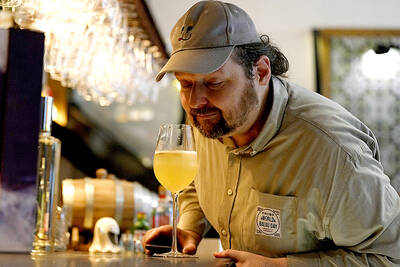Ina cramped basement in central London, two-dozen couples glide, bop and leap around a parquet floor. A few of the men have thin moustaches, waistcoasts and two-tone shoes, while some of the women have polka-dot dresses that billow out as they twirl around their partners in a tuck-turn, flat spin or a Texas Tommy. In the background, scratchy records play out trumpets, saxophones and horns in a combination of six-step jazz, blues and swing.
The idea of couples dancing the Lindy Hop seems so dated that you would think this must be a revival night — a once-in-a-while nostalgic hark-back to the 1920s, when Lindy Hop was emerging from the shadow of the mighty Charleston as the dance for the young. But you’d be wrong. Lindy Hop (also known as swing, jive and jitterbug) has been gathering a steady following in the UK for more than a decade, spurred on by the popularity of TV dance shows. All over the country, there are day courses in Lindy Hop, holidays, drop-in classes, club nights, competitions and even a trade in the associated paraphernalia — for men, retro panama hats, suits and spats; and 1940s prom dresses for women.
“When you go out swing dancing, you actually go dancing,” says Simon Selmon of the London Swing Dance Society — a Lindy Hopper of more than 20 years. When he first started teaching in the early 1990s, Selmon dreamed of getting 20 people in the class. “Now, we are busier than ever — we’re running more events and classes. We’re doing more corporate events and we’re getting requests from schools, partly because of the health aspects. Teachers also tell me it’s good communication between people and there’s teamwork involved.”
I started taking Selmon’s classes partly out of curiosity, but also because, with seven weddings to attend this year, I thought it would be useful to finally learn how to couple dance. I joined 150 or so beginners for his most popular class, Wild Times, on a Tuesday night. The lesson began with a stroll, which felt a bit like a jazzed-up line dance (I learned later that you should never call it a line dance in front of a Lindy Hopper). Ten minutes later, I was working through the basic footwork: a slow-slow, quick-quick on a six-step count. Then we headed downstairs, where more advanced dancers showed us how to do things properly.
I also tried out a smaller, more intimate class. The 52nd Street Jump, a club based in south London but named after the New York street that’s home to such jazz venues as Famous Door and Three Juices, runs 10-week foundation courses to give shy beginners the chance to screw up in front of a smaller bunch of fellow newbies. I asked instructor Steve Mason: what type of person goes along? “One minute you could be talking to a bank manager, then you’d be talking to a policeman, then you could be talking to a plasterer. How many other things in society are there where we hang around in groups of people like us? I’ve always liked the fact it’s such a mixture.”
Lindy Hop dates back to 1927, when George “Shorty” Snowden was tearing up the dance halls of Harlem. He took jazz steps from the Charleston, introduced fast break-outs (in which the woman is thrown out to the side, and then snapped back in) and won every competition and dance marathon going. After a win at the Manhattan Casino, a reporter asked what Shorty called the moves he was using. Shorty glanced over at a newspaper carrying a front-page report of the aviator Charles Lindbergh’s successful solo flight in the Spirit of St Louis from Long Island to Paris, which bore the headline: “Lucky Lindy Hops the Atlantic.” He shot the reporter back a name: the Lindy Hop.
The dance spread quickly thanks to the music of Count Basie, Benny Goodman and Glenn Miller. In the 1930s, dancers introduced the “airsteps” — acrobatics in which the man throws his partner over his head or between his legs. By the early 1940s, ballrooms across America were hosting regular Lindy Hop competitions. Swing was the pop music of its day, and Lindy Hop the way you enjoyed it.
The scene changed after World War II: the US government put a tax on dancing clubs, so tables and chairs took the place of couples on dancefloors. Rock ’n’ roll and bebop took over, and things only picked up again in the 1980s, in the clubs of New York. “Back then, if you’d said Lindy Hop, you’d have had half a dozen people who knew what it was,” says Selmon. He was learning rock ’n’ roll dances when, in 1986, his instructor suggested some new moves and a trip to the swing clubs of New York. On his return to London, Selmon set up the London Swing Dance Society. Four years later, he was teaching so much dancing he decided to take a year off his day job buying and selling antique jewelery. “That was 19 years ago,” he says. “It’s been a very long year.”
Back in the class, Selmon starts people off on the basic footwork, and adds a few turns. It’s not that difficult to learn. “You need about three months to feel comfortable then, if you want to refine it, it probably takes about a year,” he says. “You only need a dozen steps to happily dance socially all night long.”
For the first three lessons, I stared at my feet as I jerked (I don’t want to say danced) awkwardly around the floor. For the next three weeks, I was still mouthing the names of the moves, and keeping time very consciously in my head. It took around four months before I could think about leading someone for even half a song. But many of the people who started with me progressed much more quickly; my problem was that I didn’t practice enough.
One thirtysomething Londoner has come alone to Selmon’s class. “It’s something to do other than drinking all night,” he says. Another woman says she dragged her boyfriend along six months ago after coming to classes by herself for a few months. Now he’s also hooked, and they dance three or four times a week.
Lindy Hop’s appeal is easy to understand: it’s a joyous dance. “Many of the pioneers of Lindy Hop grew up in the economic depression of the 1920s and 30s, and dance was escapism, a way to forget your troubles and have fun,” says Selmon. Economic depression is not, it seems, the only thing 2009 shared with the 1920s. Eighty years later, the Lindy Hop is no longer consigned to dance history — but may just be the social dance of the future.

The unexpected collapse of the recall campaigns is being viewed through many lenses, most of them skewed and self-absorbed. The international media unsurprisingly focuses on what they perceive as the message that Taiwanese voters were sending in the failure of the mass recall, especially to China, the US and to friendly Western nations. This made some sense prior to early last month. One of the main arguments used by recall campaigners for recalling Chinese Nationalist Party (KMT) lawmakers was that they were too pro-China, and by extension not to be trusted with defending the nation. Also by extension, that argument could be

Aug. 4 to Aug. 10 When Coca-Cola finally pushed its way into Taiwan’s market in 1968, it allegedly vowed to wipe out its major domestic rival Hey Song within five years. But Hey Song, which began as a manual operation in a family cow shed in 1925, had proven its resilience, surviving numerous setbacks — including the loss of autonomy and nearly all its assets due to the Japanese colonial government’s wartime economic policy. By the 1960s, Hey Song had risen to the top of Taiwan’s beverage industry. This success was driven not only by president Chang Wen-chi’s

Last week, on the heels of the recall election that turned out so badly for Taiwan, came the news that US President Donald Trump had blocked the transit of President William Lai (賴清德) through the US on his way to Latin America. A few days later the international media reported that in June a scheduled visit by Minister of National Defense Wellington Koo (顧立雄) for high level meetings was canceled by the US after China’s President Xi Jinping (習近平) asked Trump to curb US engagement with Taiwan during a June phone call. The cancellation of Lai’s transit was a gaudy

The centuries-old fiery Chinese spirit baijiu (白酒), long associated with business dinners, is being reshaped to appeal to younger generations as its makers adapt to changing times. Mostly distilled from sorghum, the clear but pungent liquor contains as much as 60 percent alcohol. It’s the usual choice for toasts of gan bei (乾杯), the Chinese expression for bottoms up, and raucous drinking games. “If you like to drink spirits and you’ve never had baijiu, it’s kind of like eating noodles but you’ve never had spaghetti,” said Jim Boyce, a Canadian writer and wine expert who founded World Baijiu Day a decade